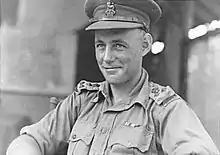Raymond Sandover
Raymond Ladais Sandover, DSO, ED (28 March 1910 – 12 August 1995) was a brigadier in the Australian Army. During the Second World War, he commanded the 2/11th Battalion from 1941 to 1943 and the 6th Australian Infantry Brigade between 1943 and 1945.[1][2][3][4][5]
Raymond Sandover | |
|---|---|
 Brigadier Raymond Sandover at Lae Base, 3 October 1944 | |
| Born | 28 March 1910 Richmond, England |
| Died | 12 August 1995 (aged 85) Surrey, England |
| Allegiance | United Kingdom Australia |
| Service/ | Territorial Army Australian Army |
| Rank | Brigadier |
| Commands held | Lae Base Sub-Area (1945) 6th Brigade (1943–45) 2/11th Battalion (1941–43) |
| Battles/wars | Second World War |
| Awards | Distinguished Service Order Mentioned in Despatches (3) Efficiency Decoration |
| Relations | William Sandover (great-grandfather) Alfred Sandover (great uncle) |
Promoted to brigadier in May 1943, at the time he was the youngest officer in the Australian Army to hold that rank.[1]
Early life and career
Born on 28 March 1910 at Richmond, London, Sandover was educated at Rugby School and the University of Bonn. In 1929, he joined a Territorial battalion of the East Surrey Regiment. He qualified as a chartered accountant and went on to work for the family business in Perth, Western Australia.[1] At the outbreak of the Second World War, Sandover volunteered to serve with the Second Australian Imperial Force. Joining the 2/11th Infantry Battalion,[1][2] he subsequently led them through the Battle of Crete.[6]
Battle of Crete
Commanding the 2/11th Battalion, Sandover took up defensive positions in the hills around the airstrip of Rethymno, Crete, along with the 2/1st Battalion, supported by elements of 2/3rd Field Regiment, 2/1st Machine Gun Battalion and members of the Cretan Police. Lieutenant Colonel Ian Campbell, commander of the 2/1st Battalion, was appointed overall commander of the Rethymno Force.
On 20 May 1941 German paratroopers landed on Crete. The fighting was severe at times as the Australian and Greek units fought to contain the German landings.
Campbell's forces were doing well in comparison with allied efforts on other parts of the island. The 2/11th Battalion along with the Cretan Police were able to force back the German paratroopers to Perivolia in which the 2/11th Battalion, in a series of counter attacks, attempted to drive the German forces from the village.
On 28 May the British main force was in full retreat. Messages to Lieutenant Colonel Campbell informing him of the retreat and evacuation never reached Rethymno. By 29 May the Rethymno force was trapped but had still denied German forces the airfield.
On 29 May Lieutenant Colonel Campbell surrendered but Sandover gave his men the option of either surrendering or, after destroying their weapons, taking to the mountains and escaping from Crete in anyway possible. Many of Sandover's men took the latter option and evaded capture, living in the mountains with assistance from the local civilian population.[7]
Battle of Wide Bay–Open Bay
The landing at Jacquinot Bay was an Allied amphibious operation during the New Britain Campaign that was conducted as part of a change of garrison with the Australians taking over from US Infantry Divisions.
On 4 November 1944, Sandover's 6th Brigade landed largely unopposed with the initial landing by 14th/32nd Battalion with support from naval forces and aircraft.
Promotions
Sandover was promoted four times from 1941 to 1946.[5]
|
Temporary lieutenant colonel |
|
Lieutenant colonel |
|
Colonel |
|
Temporary brigadier |
|
Granted the honorary rank of brigadier |
Commands
Sandover commanded the 2/11th Infantry Battalion, the 6th Australian Infantry Brigade and the Lae Base Sub-area. He retired from military service on 19 January 1946.[2][4][5]
|
1 May 1943 | Commanding Officer 2/11th Infantry Battalion. |
|
27 July 1945 | Commanding Officer 6th Australian Infantry Brigade [New Britain]. |
|
11 December 1945 | Commanding Officer Lae Base Sub-Area. |
|
Retired from Military Service. |
Awards and honours
Sandover was Mentioned in Despatches on three occasions and awarded the Distinguished Service Order (DSO) for leadership during the advance to the Wide and Open Bay areas during the New Britain Campaign.[8][9][10][11][12]
- 23 June 1942 – Mentioned in Despatches
- 19 July 1945 – Mentioned in Despatches for distinguished services in the South-West Pacific Area.
- 14 February 1946 – The Distinguished Service Order (DSO) for leadership during the advance to the Wide and Open Bay areas in 1945.
- 6 March 1947 – Mentioned in Despatches for exceptional service in the field in the South-West Pacific Area.
Post-war
After the war he returned to England where he was a director of the family business. He died 12 August 1995 at Surrey, England.[1][3]
References
- "The Daily Telegraph, London. Obituaries". 16 September 1995.
- "Exploring Surrey Past" (PDF). Retrieved 29 October 2015.
- "The London Gazette" (PDF). 7 November 1995. Retrieved 29 October 2015.
- "Temporary Brigadier Raymond Ladais Sandover | Australian War Memorial". www.awm.gov.au. Retrieved 2015-10-29.
- "Biography of Brigadier Raymond Ladais Sandover (1910 – ), Australia". www.generals.dk. Retrieved 2015-10-29.
- "Guarding it even in death: The Australians at Rethymno 20–29 May 1941". Australia's War 1939–1945. Australian Government. Retrieved 1 November 2015.
- "Australians in World War 2: Greece and Crete".
- "Temporary Brigadier Raymond Ladais Sandover | Australian War Memorial". www.awm.gov.au. Retrieved 2015-10-31.
- "Australian War Memorial". Retrieved 31 October 2015.
- "Australian War Memorial". Australian War Memorial. Retrieved 29 October 2015.
- "Australian War Memorial". Retrieved 29 October 2015.
- "Australian War Memorial". Retrieved 31 October 2015.